Glossary - alphabet order - "F"
Feedback resistor
This is a component in a crystal oscillation circuit. See "crystal oscillation circuit".
Reference: Crystal oscillation circuit
Flexure vibration
Flexure vibration is a vibration mode (style) of crystal chips, in which flexure motion of the vibrating piece is used as the oscillation source, such as in tuning fork crystal chips. This type is suited for low-frequency crystal devices.
Reference: Tuning fork crystal unit
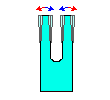
Flexure vibration
Frequency
The frequency is the density of cycles (waves) per unit of time (one second). The relation between frequency (f) and cycle time (t) is f (Hz) = 1/t (s).
Frequency control range
In a voltage controlled crystal oscillator, the range of frequencies that can be controlled by an input to the Vc pin. Here, APR (absolute pull range) refers to the range of frequencies that can be controlled from the nominal frequency value. In other words, APR = frequency control range - frequency deviation (frequency tolerance).
Frequency pulling range
This is the range in which the frequency can be changed by input to the Vc pin in a voltage controlled crystal oscillator.
Reference: Voltage controlled crystal oscillator
Frequency stability (Frequency tolerance)
Frequency stability refers to defining a crystal oscillator's specified tolerance ranges (including the tolerances for frequency-temperature characteristics and frequency-voltage characteristics) (Δ f) for specified output frequency (fo) within the specified temperature conditions and operating voltage range. It is usually expressed as a ratio (Δ f/fo).
Frequency versus temperature characteristics
This refers to the variation in frequency due to ambient temperature changes, relative to the reference frequency at +25 ℃. The frequency-temperature characteristics are generally expressed by the following approximate formula.
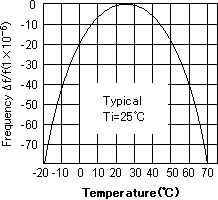 |
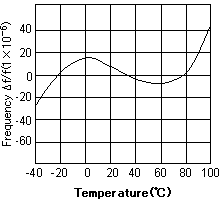 |
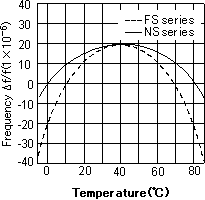 |
| Example of tuning fork crystal unit's frequency-temperature characteristics | Example of AT crystal unit's frequency-temperature characteristics | Example of SAW resonator's frequency-temperature characteristics |
- Tuning fork crystal unit. SAW Resonator.
f_tem=B (Ti-θX)2 θX:specified temperature - AT crystal unit.
f_tem=α (θX-25)+β (θX-25)2+γ (θX-25)3 - SAW resonator, SAW oscillator:Δf/f = a(θT-θX)2
Seiko Epson offers SAW resonators/oscillators with a normal level of frequency-temperature characteristics as well as those with a half coefficient of frequency-temperature characteristics (New SAW: NS-32R, EG-2121, EG-2102).
Frequency tolerance
The frequency tolerance, when applied to the frequency specification of the crystal units and SAW resonators, indicates the deviation (Δf) of the actual frequency (measured value) from the nominal frequency value (f) within the +25 ℃ ambient temperature and specified conditions. It is usually expressed as a ratio (Δf/f).
Reference: Frequency stability
Frequency voltage characteristics
Using the output frequency at the central value of the operating voltage range as a reference, frequency voltage characteristics describe variation in output frequency. Variation in frequency due to variation in voltage can be caused by changes in crystal strain or changes in the internal constants of the IC that is built in a crystal oscillation circuit or real time clock. The IC generally plays the greatest role in causing this variation.
Fundamental mode
This is the first (fundamental) vibration order among the vibration orders excited by an AT vibration mode. The stable oscillation provided by the fundamental order makes it easier to design a crystal oscillation circuit than if a higher (overtone) oscillation order were used.
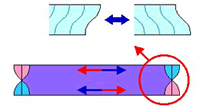 |
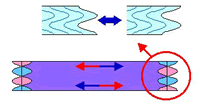 |
| Fundamental mode | (Reference)Third overtone mode |
Reference: Thickness shear vibration , Overtone mode
